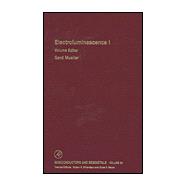Electroluminescence: Electroluminescence I
, by Mueller, Gerd- ISBN: 9780127521732 | 0127521739
- Cover: Hardcover
- Copyright: 11/1/1999
The volume "Electroluminescence" for the first time covers (almost) all kinds of electroluminescence. In its broadest sense electroluminescence is the conversion of electric power into optical power - light. The way, in which this goal is accomplished, and the goal, the application itself, has varied over time. First reported in the scientific literature in 1936 by the French physicist G. Destriau, it was for quite some decades the glow of a powder embedded in a resin under the action of an alternating voltage. The dream of "cold light" for illumination was born in the 50s. Modern semiconductor technology, using p-n juntion, but not in silicon or germanium, but in GaAs and GaP, created in the 70s the tiny Light emitting Diodes. Today about 50 for every human being have been sold. They are everywhere for signaling and display of numbers and short texts. And they are at the verge of an era of solid state lighting, replacing gradually incandescent bulbs and fluorescent lamps. In the first half of 1999 several j oint ventures between giants of the lighting industry and manufacturers of LEDs became known, including names as Philips, General Electric, Osram and Hewlett Packard, Emtron and Siemens, The reason, blue light emission of LEDs, for so long researched for unsuccessfully, has been achieved. Signaling, lighting will be the domains of LEDs in the next decades - a good start in the 21st millenium. But a the same time a paradigm shift in the display industry could come about. Dominated for the last 10 years by Liquid Crystal Displays (LCD), which are reflecting or transmitting light from extra light sources, self-emitting displays will challenge this dominance. Capable of handling very complex information by multiplexed addressing of millions of picture elements (pixels) in full color electroluminescence in the form of Organic LEDs and Thin Film Electroluminescence is gaining markets. Both technologies, much less matured than LED, incorporate much different physical features. The broad materials potential almost unexplored in both cases, they are good for surprises. The volume tries to present overviews ovber the 3 different technologies, covering in each case the mechanisms, the most important material properties, essential for the implementation of the working principles, the major applications and the system aspects. The reader will learn how the new long-life, maintenance free, power saving red traffic lights in the Silicon Valley function, and what the tail lights of his next car will be. The fascinating physics of polymer light emitters, eventually manufactured in a roll-to roll process, for cellular phones, or hand-held wireless computers, will become transparent. And why is it that up to now only sulfides can be used for the simplest design of displays capable of proven multiplex ratios of 1000? The comparison of the different electroluminescences, if this plural exists, will hopefully give experts of one of the fields, students of any of them, and application engineers new insights and ideas. Materials scientists and engineers will be caught by the comparison i n analyzing what else one could provide to improve performance. General Description of Semiconductors and Semimetals: Since its inception in 1966, the series of numbered volumes known as Semiconductors and Semimetals has distinguished itself through the careful selection of well-known authors, editors, and contributors. The Willardson and Beer series, as it is widely known, has succeeded in producing numerous landmark volumes and chapters. Not only did many of these volumes make an impact at the time of their publication, but they continue to be well-cited years after their original release. Recently, Professor Eicke R. Weber of the University of California at Berkeley joined as a co-editor of the series. Professor Weber, a well-known expert in the field of semiconductor materials, will further contribute to continuing the ser






